/ Blog
13 Reasons Why Your Email Campaigns End Up As Spam (And How To Avoid Them)
Kalpana
Content Marketer
- DATE PUBLISHED (20/9/2021)
- READ TIME (5MIN)
<iframe allowfullscreen="false" data-src="https://spkt.io/a/2849945" frameborder="0" id="speechkit-io-iframe" scrolling="no" style="display: none"></iframe><script src="https://proxy.speechkit.io/npm/@speechkit/speechkit-audio-player-v2@latest/dist/module/speechkit-iframe-helper.js" type="text/javascript"></script>
Remember the 90s? A glorious time without inboxes, emails, or unfiltered spam from that-random-brand-with-50%-off-on-products-you-impulsively-ordered-at-3am?
Yeah, I do too. I’m guilty of sharing my data with random brands that I discover online, only to Google how to set up email filters the next morning. But then again, email providers are also cracking down and spam filters are getting smarter, so my late-night jaunts on the internet can continue to get more adventurous with time.
But this article isn’t about me. It’s about email deliverability.
It’s about you - an enterprising brand owner or marketing manager trying to genuinely communicate with your customers, share essential updates, and add value to their lives.
But if your subscriber engagement has nosedived and your open rates are super low, chances are that your email hygiene isn’t exactly in place.
Email marketing is still alive and kicking.
Segmented and effective email marketing campaigns can deliver a whopping 760% increase in overall revenue. It doesn’t matter if you’re a brick-and-mortar store or a digitally native brand selling products on Instagram - you need an efficient email strategy to engage and bring back shoppers.
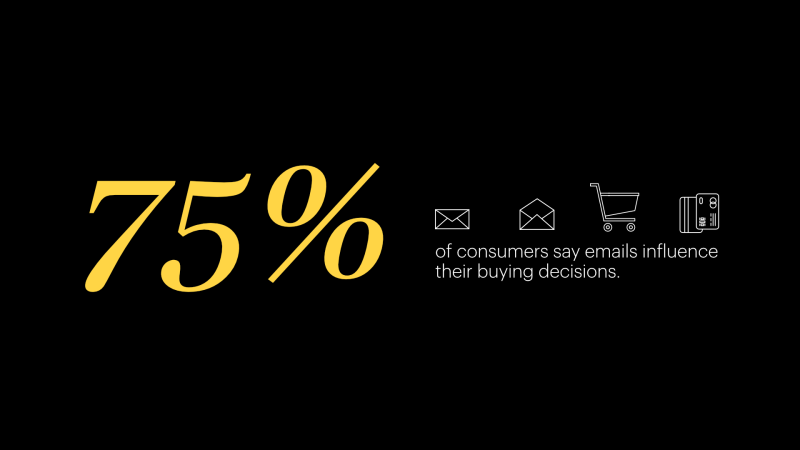
Source: https://blog.hubspot.com/marketing/email-marketing-stats
So yes, email is still hot. But that’s also the problem.
Because every small brand is aggressively doing it. It’s why spam filters exist.
So how do you make sure that your emails avoid the spam folder? And more importantly, how can you craft emails that consumers read and recognize? But before we begin, let’s first see what spam messages are and how they’re identified.
There are 3 checkpoints that flag spam.
When we talk about spam, it’s worth thinking about the levels in which users are protected.
1. Spam Filters
These are algorithms that detect and redirect unwanted emails to the spam folder. They filter emails based on the sender’s information and reputation. They check the sender’s IP address, domain, campaign engagement rates, and unsubscribe rate.
2. Anti-Spam Laws
There are international data protection and anti-spam laws that protect netizens. The four most popular regulations are America's Controlling the Assault of Non-Solicited Pornography And Marketing (CAN-SPAM), Canada's Anti-Spam Legislation (CASL), Europe's General Data Protection Regulation (GDPR), and The Spam Act 2003 (Aus).
These laws define how you can collect, manage, and use consumer data. If you violate any of these laws, you can be penalized upto $41,000 per email.
3. ESPs & Spam Complaints
When you choose low cost ESPs without looking into their reputation, chances are that other spammers are also using their service. And because you will be using your ESP’s servers to send out campaigns, your emails will also be marked as spam.
Most ESPs have a “Complain Spam” or “Report Spam” option which enables customers to report these. Your Internet Service Provider (ISP) will then send feedback to the ESPs based on the complaints. A high complaint rate can land your emails in the spam folder.
With that in place, let’s take a look at why your emails might end up as spam.
13 reasons why emails end up as spam.
1. You don’t have permission to send emails.
45% of consumers avoid opening emails from unknown email addresses.
When you buy email lists from external vendors, you get access to thousands of email IDs. Sure, that sounds like a sugar rush for marketers - till it becomes a nightmare. These email lists aren’t segmented or categorized. There’s no easy way to understand if your products are relevant to this audience, or if these consumers would be interested in your offer.
Simply having access to their email IDs doesn’t mean that you have their consent to be contacted. People react pretty badly to cold emails from unknown IDs - your emails are likely to be marked (and later automatically re-rerouted) as spam. This problem compounds.
So here’s the 1st rule in email marketing. You need consent. It’s also the 2nd rule.
2. Your emails are not personalized.
Here’s an email that we love from Beardbrand that hits all the right chords.
It’s clean, it’s simple, it’s personalized to the customer, and it does the job.
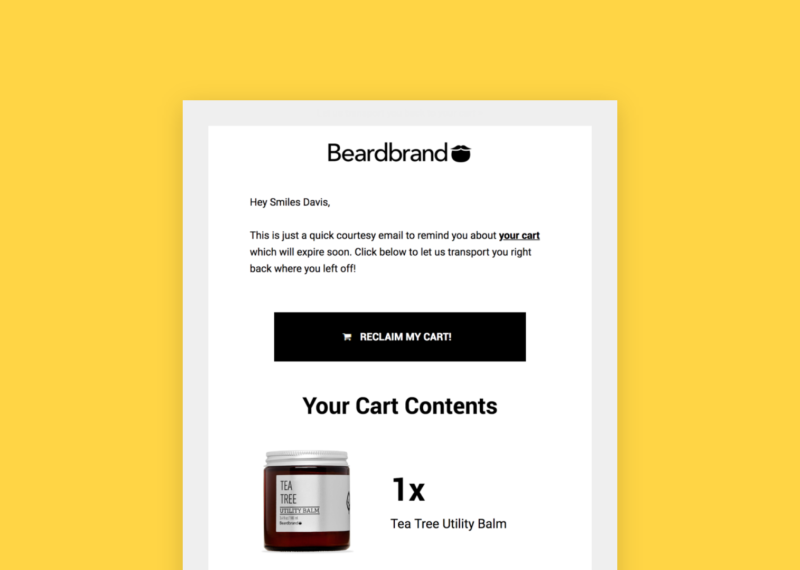
Customers will unsubscribe if you constantly share campaign emails without personalization or an understanding of their interests. And when a lot of people unsubscribe from your emails, your ESPs will mark you as spam.
3. Your engagement rates are low.
Email Service Providers calculate your engagement rate based on the actions of your consumers. This is based on:
How many people read your email?
How long do they spend reading?
Do they forward it to someone?
Do they reply or click on the link in your email?
Do they unsubscribe from your email list?
Low engagement rates or a high number of unsubscribers can redirect your campaigns to the spam folder. Higher engagement rates will proportionally improve your email deliverability rate. The average email open rate is 12% and unsubscribe rate is 0%.
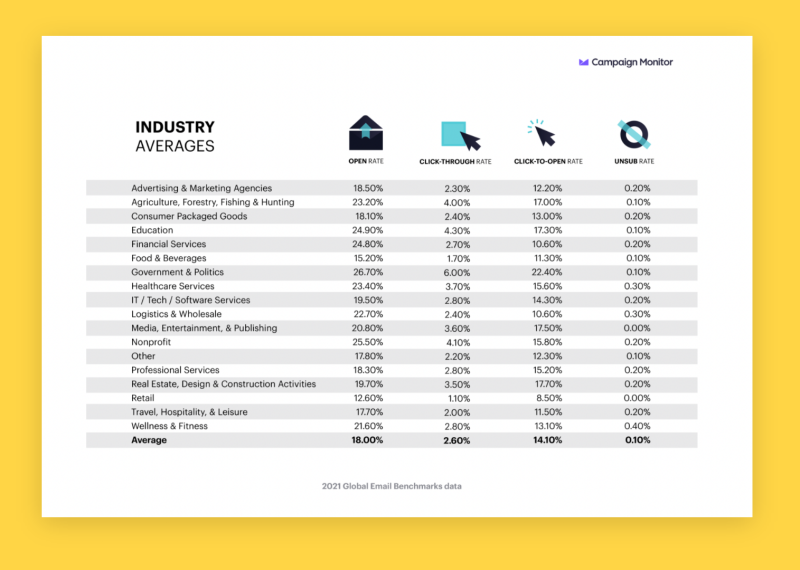
Source: https://www.campaignmonitor.com/resources/guides/email-marketing-benchmarks/
4. Your email list is not updated (or maintained).
If you have an email list that you’ve gathered over time, there might be some invalid or irrelevant IDs hiding in the list. If you’ve set up automated email flows, your brand might continue to send emails to these inactive IDs or infrequent customers, lowering your overall engagement rate.
This in turn will affect your email deliverability.
This is a also common problem that happens if you:
Buy or scrape email IDs from the internet
Have email IDs with typos in your list (name or domain name)
Have invalid email IDs that are no longer active in your list
Customers who don’t engage with your brand need to be rigorously removed from your email database. Not only does this improve your campaign engagement, it’s also thoughtful!
Use email validation tools like Zerobounce or Bouncer to maintain email lists that work.
5. Your content is... spammy.
If it looks like spam and reads like spam, 90% of the time - it is spam. Spam filters know this, so they check your email content for commonly used trigger words.
Check out this blog for a full list of spam triggering words based on your industry.
Try not to write clickbait content that’s designed to hoodwink people into opening emails. This is an old technique, and can backfire on your brand in more ways than one.
Algorithms are super intelligent, and they will redirect your emails to spam folders if they find suspicious words, far-fetched offers, manipulative content, questionable claims or consistently deep discounts. Try to convince your customers by adding value, sharing content that might inspire them, or sharing your brand story without aggressive marketing tactics.
Writing good emails can be time consuming and hard, but it’s worth the effort.
6. Subscribers don't recognize your brand.
Is your brand messaging memorable and consistent? Can customers identify you with your voice, tone, and design style? Invest in making this happen.
The worst thing that could happen to your brand is customers not recognizing you. When this happens, they’re likely to be alarmed and mark your emails as spam. Yes, even if they’d voluntarily subscribed through your outreach ads or lead magnets.
Branding, when done right, can work wonders for your business. Take Casper, for example. Casper’s emails are beautifully tied together with consistency, making them stand out in a crowded inbox and improving their CTR naturally.
Build responsive HTML emailers (avoid static images like the plague!) that look great, follow email HTML standards, are easy to read, and visually appealing. Badly optimized emails or static emails can hurt both your branding and your email marketing strategy.
7. Your IP address is blacklisted as spam.
Bad email practices followed by someone else in your organization can also affect your email deliverability. This is because ESPs blacklist certain IP addresses as spam, if a high volume of emails is routinely delivered from the IP address over time.
Enable SMTP authentication, control email relays, set up an SPF record, and configure your SSL to make sure that your email servers aren’t vulnerable to interference.
Constantly monitor your IP address to check your reputation and see if your servers have been accidentally (or deliberately) blacklisted.
And some other reasons…
8. Your emails don’t have a physical address.
Not having a physical address in your email is a violation of the CAN-SPAM Act. This can impact email deliverability, and also contribute to low customer trust.
9. Your sender name isn’t well-defined.
Almost 42% of the consumers look at the sender’s name before opening an email. If your sender name isn’t authentic or brand related, they might mark the email as spam. Plus, the CAN-SPAM Act requires you to provide accurate sender information.
10. Your email subject line is misleading.
Manipulative or clickbait-laced subject lines create a bad impression with buyers. Spam filters are also likely to flag subject lines with words like ‘free’, ‘hurry’, ‘offer’, and ‘now’. While you’re at it, avoid special characters like exclamation marks, famous names, and baseless claims.
11. Your email frequency is inconsistent.
Do you have a 'Subscribe' button on your website? How often do you send newsletters to your subscribers? If you email them once in a few months, it’s too little. If you email them every week, it’s too much. Find a frequency that works for your subscribers.
A Hubspot study shows that 78% of people unsubscribe from emails because they receive too many emails in a day. Be active, not annoying. A high unsubscribe rate and low engagement rate will land you in the spam folder.
12. Your emails don’t feature an unsubscribe option.
An unsubscribe option is mandatory, and the lack of this option can flag your emails as spam and lower your email deliverability. Under anti-spam laws, your business could also be penalized for not having an option to unsubscribe. Bear in mind that using deliberately bad UX to make unsubscribing difficult can also qualify as spam, so this is best avoided.
13. Your emails have links to suspicious websites.
As a best practice, we encourage merchants to use hyperlinks with the same core domains across the email, to signal to the ESP that this is well-branded communication. External links, shortened URLs that redirect one too many times, and links to less trusted and suspicious websites can undermine the quality of your email and move it to the spam folder.
Always double check your links, and keep them relevant!
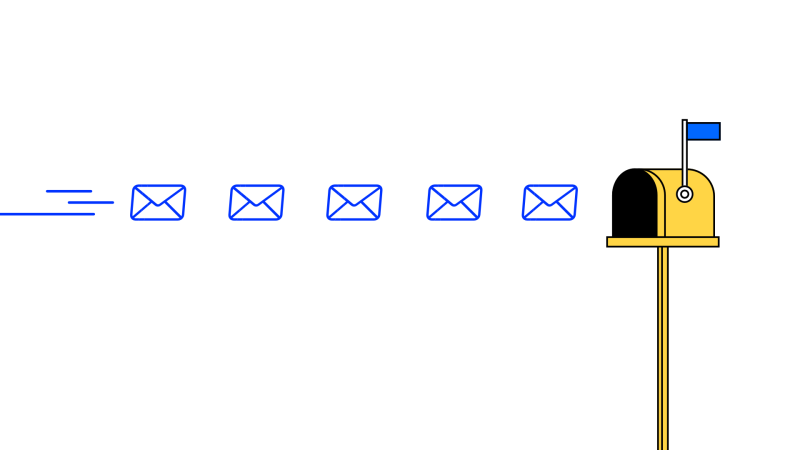
How to improve your email deliverability.
Here are some best practices that we recommend.
1. Build your own email list.
Email lists are like the 1000+ friends that you have on Facebook. Sure, it’s a great number - but you don’t really know all of them, do you? Real relationships take years to build, and it’s a slow process of building trust and mutual respect. Think of your email subscribers in these terms.
Organic lists are difficult to build, but they lay the foundation for a life-long business. You will know what will motivate your shoppers to buy and how to communicate to them.
Protip
If you’re just starting out, it’s good to have a small email list. Start with friends of the business and grow organically.
2. Validate your email list regularly.
What matters is how subscribers are engaging with your emails. This is true especially when you are a D2C brand, where free email accounts (like Gmail, Hotmail) are common and tricky to verify. No matter the scale of the brand, a clean email list will boost your email deliverability and nurture long-term relationships. Make sure you:
Clean your email list every quarter with validation tools
Create flows to remove unengaged users with low open rates and CTR
Verify email IDs for typos and other human errors
Protip
Use segments to understand your most engaged customers and build your credibility with them before you gradually contact others in your pipeline.
3. Use the double opt-in method.
If you’re running lead generation campaigns, remember that not all the IDs that gather in your forms are legit. More than half of your email leads will be from junk IDs or bots. People really just want a copy of your playbook or see the discount your coupon offers.
With a double opt-in, you can send an automated email to subscriber IDs with a confirmation button. Only users who click on the confirmation button will be entered into your subscriber list. This helps you weed out bots and concentrate only on genuinely interested customers.
Protip
To boost your double opt-in rates, offer discounts or value-adds. Incorporate brand colors and logos across the confirmation process.
4. Add an easy way to opt-out.
Even though this might seem to impede your list-building goal, keeping your unsubscribe option easy will help you concentrate on people who are interested in your products. The CAN-SPAM Act requires you to provide an Unsubscribe option in every email you send.
Most emails have an unsubscribe link at the bottom. This will reflect your confidence in the quality of products you offer. People like brands that are confident and respect their (un)subscribers.
Protip
Set up an unsubscribe workflow with 3 selections:
Understand why they are opting out to improve future campaigns.
Help them unsubscribe from an email list instead of opting out entirely.
Ask them to stay connected with you on your social profiles.
5. Request your subscribers to whitelist you.
Getting whitelisted shows ESPs that you’re trustworthy.
Ask subscribers to add your email IDs to their contacts, to improve the overall trustworthiness of your domain.This is particularly achievable for boutique brands with loyal customers.
Add these instructions to your welcome email to help your subscribers know what to do.
Protip
Even though your emails are whitelisted, they can still be hidden in the Promotions or Social tabs. For your emails to land on the Primary tab, you can ask your subscribers to drag your emails from other folders to their Primary tab.
This is a hard sell, but when done right, it works!
6. Share relevant and relatable content.
It’s a myth that people hate emails - they just hate irrelevant emails. Instead of heavily relying on product recommendations, send emails that pique their interest and resonate with them.
You can nail down relevancy and create personalized experiences only when you truly know and understand your customers.
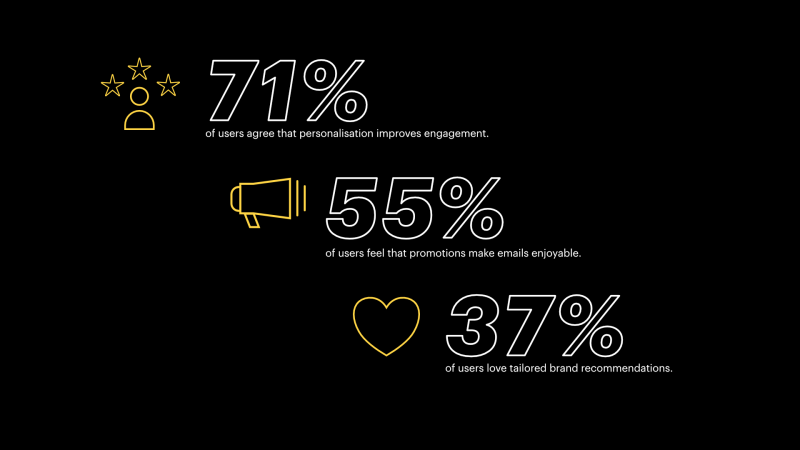
Source: https://www.dynamicyield.com/guides/state-personalization-email/
Here are some relevant ideas:
Price Alerts: On products they frequently buy or in their wishlist and cart
How To Videos: Product usage videos, best practices, FAQs, things to know
Protip
Always ask this question before sending out a campaign:
Is this email important to my buyers?
Is this email important to my buyers right now?
If both questions are satisfied, hit ‘Send’.
7. Be authentic and transparent.
Anti-spam laws were incorporated for brands to be reliable. People do read cold emails and cart abandonment emails. They just want brands to be more transparent and less deceptive in their communication.
You can make a great first impression by being authentic.
Add your physical address to increase transparency and trustability.
Respect unsubscribers and remove them from your email list.
Let audiences know when you are sending them an advertisement.
Use subject lines that convey the true value of your email.
Keep your email campaign free of all spam(my) texts.
8. Treat email marketing as a brand-building tool.
Treat your campaigns as a demand generation tool, and not as a lead generation tool.
“Don’t think of emails as an afterthought when you plan your communications. Email has definitely been a big part of cultivating lifetime value for our customers. It's also been a great way to get new customers into the funnel.”
Lauren Haas, Director of Integrated Marketing, Eight Sleep
Shoppers don’t just read emails - they’re also active on social media. Create a consistent and memorable brand experience across channels, so that shoppers recognize your brand.
We recommend:
Consistent typography, color, logo, and illustrations
A sender name to humanize your brand emails
Mobile responsive and easy-to-read templates
High contrast CTAs with actionable text
Clear and honest copy that delivers the goods
Optimized images for reduced load times
And that’s all, folks!
Emails, when used correctly, can generate $42 for every dollar spent, with 4200% ROI.
Be authentic, be consistent, and watch your email deliverability grow by leaps and bounds.
What are your go-to tips for email marketing? Hit us up and let us know!